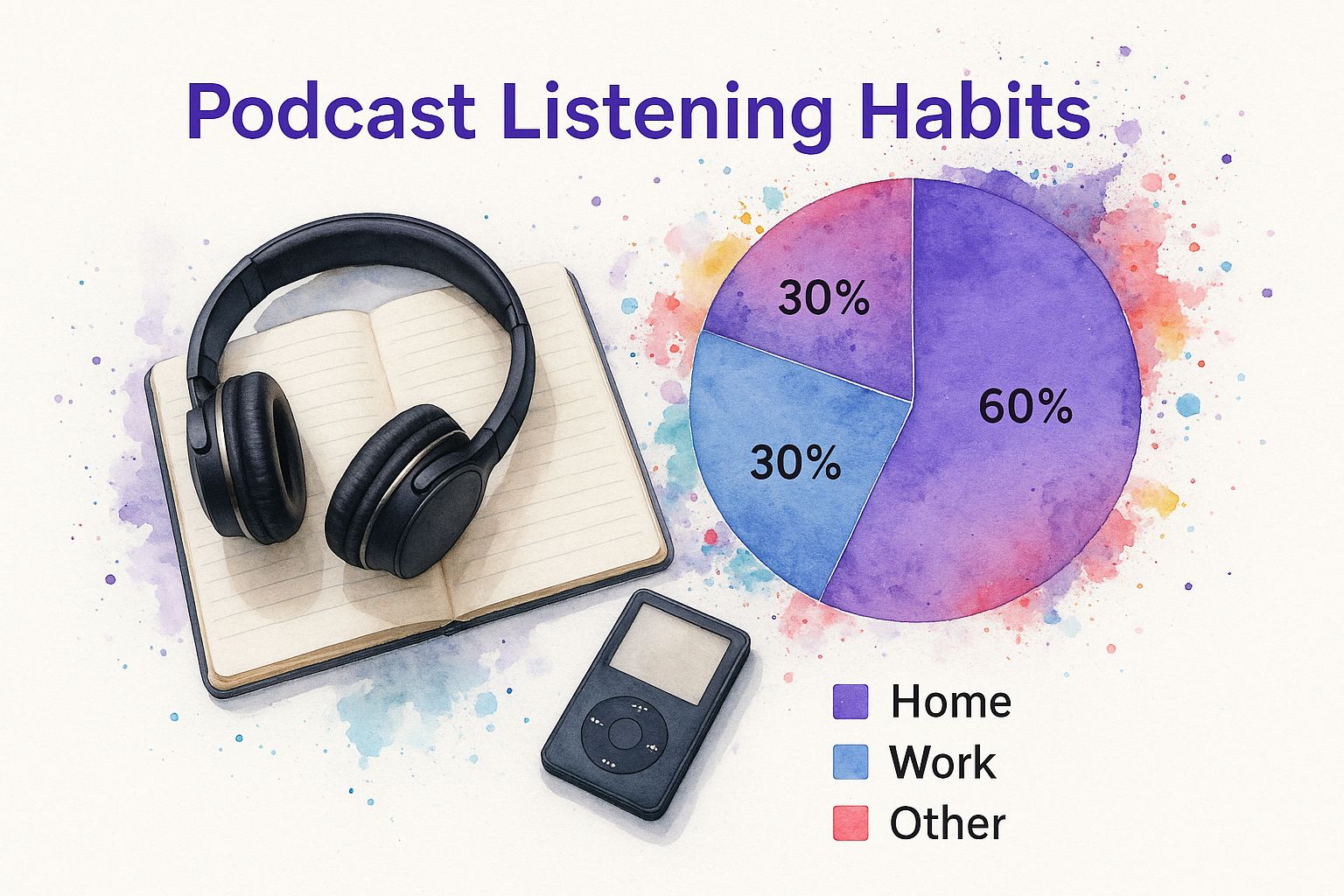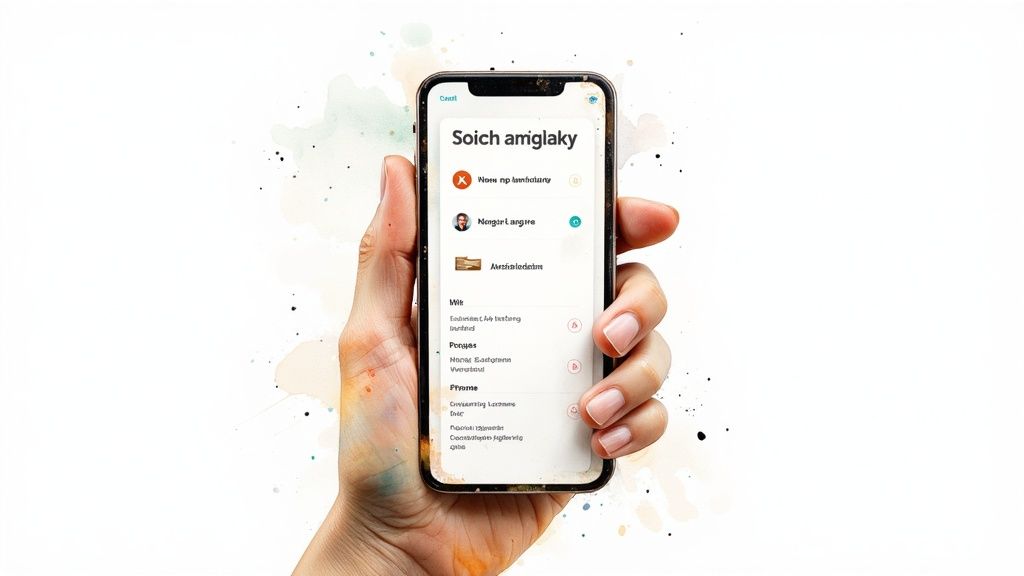How to Improve English Speaking Skills That Actually Stick
Discover how to improve English speaking with practical habits, smart tech, and confidence-building techniques. A real-world guide to lasting fluency.


If you want to get better at speaking English, it’s all about building small, consistent habits. Forget cramming for hours. The real magic happens when you weave tiny, active practices into your daily life—things like thinking in English or mimicking how native speakers talk. This is how you turn what you know into what you can do.
Build a Foundation with Daily Speaking Habits

You don't need huge blocks of free time to see real progress. The secret to speaking English with confidence is finding ways to fold practice into your everyday routine. It’s about turning otherwise boring moments into a chance to level up.
The aim here is to make English feel like a natural part of your day, not just another task to check off your to-do list.
Turn Passive Listening into Active Practice
One of the most effective techniques I've come across is shadowing. It's incredibly simple: you listen to a native English speaker and repeat what they say almost simultaneously, like an echo. You're not just memorizing words; you're actually absorbing the rhythm, intonation, and natural pronunciation of the language.
Here's a simple way to get started:
- Find your source: Grab a short podcast clip, a scene from a favorite TV show, or a clear YouTube video. Anything with a native speaker works.
- Listen once: Play the clip through one time just to get the gist of what's being said.
- Shadow it: Now, play it again, but this time, speak along with the audio. Don't stress about getting every word perfect. Your goal is to match the speaker's cadence and flow.
- Repeat daily: Just five minutes of this a day is all it takes. Repetition is key because it builds muscle memory for your mouth and tongue, making English sounds start to feel second nature.
"The secret to fluency is frequency. Small, daily interactions with the language compound over time, building a foundation that is much stronger than sporadic, intensive study sessions."
Start Thinking in English
Here's another game-changer: start narrating your life in English, but just inside your head. This habit takes zero extra time and starts to shift your brain from constantly translating to thinking directly in English.
Begin with the small stuff. As you make your morning coffee, think, "Okay, I'm pouring the water now. I need to get a mug from the cupboard." On your commute, describe what you see out the window: "That man is reading a book. The bus is turning left."
This internal monologue is a powerful way to train your brain to form sentences on the spot. As you get more comfortable, you can move on to summarizing a news article you just read or planning out your entire day—all in English, all in your head. It's a completely private, no-pressure way to practice constantly.
This kind of consistent, low-stakes exposure is critical. A global study of 2.1 million adults showed that countries with the highest English proficiency were the ones where people integrated the language into daily life.
By turning these quiet moments into active practice, you’re essentially rewiring your brain for English fluency. When the time comes to actually speak out loud, you'll find the words flow much more easily because you’ve been practicing them all day long. For more structured practice, you might be interested in seeing how tools like TalkEasy can streamline this process and help turn those thoughts into confident speech.
Use Technology for Realistic Conversation Practice
Forget the old idea that you need a classroom or a live-in tutor to get better at speaking English. The truth is, some of the most powerful language-learning tools you can find are probably sitting in your pocket right now. Technology gives you a safe, judgment-free space to build that crucial conversational muscle memory.
This means you can practice anything from ordering a coffee to handling a tricky business negotiation, all on your own terms. The real secret isn't just having the tools, but knowing how to use them for active, realistic practice instead of just passive listening.
Embrace AI for Low-Stakes Conversations
Artificial intelligence has completely changed the game for anyone learning a language. AI-powered platforms can simulate real-world conversations, letting you practice without that nagging fear of making a mistake in front of a real person. Building confidence this way is a massive advantage.
These tools are built to be patient and responsive. They don’t get tired, and they certainly don't judge you for stumbling over a word. This creates a low-pressure environment where the only thing that matters is your improvement.
Think of an AI partner as your personal conversational sandbox. It’s a place where you can try out new vocabulary, experiment with different ways of phrasing things, and just find your rhythm in a supportive setting. The goal is to make speaking feel less like a test and more like something you just do.
A study on language learning found that learners who consistently engage in active speaking practice, even with AI, show a 20-30% increase in fluency over six months compared to those relying only on passive methods.
Get Instant Feedback to Correct Mistakes in Real Time
One of the best things about practicing with technology is getting immediate feedback. When you’re talking to a person, they might not correct every little error because they want to keep the conversation flowing. An AI, on the other hand, can be programmed to catch those slip-ups.
This real-time correction is a game-changer for two key areas:
- Pronunciation: Good AI can analyze your speech and pinpoint the specific sounds you’re struggling with, giving you instant tips on how to fix them.
- Grammar: You can get immediate suggestions on better word choices or sentence structures, which helps you break bad habits before they stick.
This tight feedback loop is what really speeds up your learning. Instead of wondering if you said something correctly, you know right away. You can find out more about how platforms like TalkEasy offer personalized AI-driven practice to sharpen your skills.
Use Your Phone as a Personal Speech Coach
Beyond specialized apps, you already have a simple but incredibly powerful tool: the voice recorder on your phone. It’s a surprisingly effective way to analyze your own speech and see your progress over time.
The process is simple. First, pick a topic—any topic—and record yourself speaking about it for a minute or two. You could try summarizing a news article, describing your day, or even practicing your answer to a common interview question.
Next, and this is the important part, listen back to the recording with a critical ear. Don't just hunt for mistakes. Pay attention to your pacing, your use of filler words like "um" or "like," and the overall clarity of your speech. Do you sound confident? Is your intonation natural, or does it sound a bit flat?
Jot down just one or two specific things to work on. Maybe you notice you always stumble on a particular word, or you tend to hesitate a lot. The next time you record yourself, focus only on improving those specific things. Hearing your own voice is a powerful motivator, and it provides undeniable proof of how much you're actually improving.
Master Pronunciation to Speak with Clarity
Knowing the right words is a great start, but it's only half the battle. The real magic happens in how you say them. Your pronunciation, rhythm, and intonation are what make your speech not just understandable, but truly clear and confident. Getting these right is a massive leap forward in your English speaking journey because it directly affects how well people catch your meaning.
Many learners get so wrapped up in grammar rules that they forget about the "music" of English. This includes things like sentence stress—which words you punch a little harder—and intonation, the natural rise and fall of your voice. Nailing this can completely change the feel of a sentence and is often what separates a fluent speaker from someone who sounds a bit robotic.
Focus on Individual Sounds and Word Stress
The best way to begin is by zeroing in on the specific sounds that trip you up. English is notorious for having sounds that might not exist in your native language, which can make them a real headache to get right. Think about the subtle difference between "ship" and "sheep," or the classic "th" sound.
Here are a few targeted exercises I’ve seen work wonders:
- The 'th' Sound: This one's a classic for a reason. Place your tongue lightly between your teeth and blow air out. Start practicing with words like "think," "three," and "that." It feels weird at first, but it works.
- Vowel Sounds: Minimal pairs are your best friend here. These are words that differ by just one sound, like sit/seat or pull/pool. Record yourself saying them and listen back. You'll quickly hear where you need to adjust.
- Word Stress: Every English word with more than one syllable has a stressed syllable. For instance, you say "pro-gress" for the noun but "pro-gress" for the verb. Little shifts like this change the whole meaning. A good online dictionary with audio is perfect for hearing and copying these patterns.
The infographic below really drives home how different learning activities work together to sharpen your speaking skills.

As you can see, actively mimicking what you hear and using tools that give you feedback are absolutely essential for making real progress with pronunciation.
To help you get started, here's a quick guide to some of the most common pronunciation hurdles learners face.
Common Pronunciation Mistakes And Corrections
This table is a handy reference for identifying and fixing common English pronunciation errors that can get in the way of clear, fluent speech.
Keep this table in mind as you practice. Catching these small but frequent mistakes can make a huge difference in how natural you sound.
Use Visual Tools to See How Sounds Are Made
Sometimes, just listening isn't enough—you need to actually see how a sound is made. This is where visual aids are a game-changer. You can find tons of online phonetic charts and YouTube tutorials that give you a front-row seat to the mechanics of English sounds.
Watching a slow-motion video of a native speaker's mouth can be a lightbulb moment for those really stubborn sounds. You can see exactly what they're doing with their lips, jaw, and tongue, and then try to copy it in front of a mirror. This creates a powerful feedback loop that makes those abstract phonetic rules feel much more real.
By focusing on the physical mechanics of speech, you're not just guessing anymore. You're training your facial muscles to produce sounds accurately, which is a fundamental part of speaking English clearly and confidently.
This kind of deliberate practice builds muscle memory, and over time, that correct pronunciation will become second nature.
Turn Passive Vocabulary into Active Fluency
Have you ever found yourself understanding thousands of English words in a book or a movie, but when you try to speak, you can only grab a handful? That frustrating experience is the classic gap between your passive vocabulary (words you recognize) and your active vocabulary (words you actually use).
Closing that gap is one of the biggest leaps you'll make in your speaking skills. The real work isn't about cramming more words into your brain; it's about learning to use the ones you already know. You're essentially moving words from the "Oh, I know what that means" file to the "I can say that without thinking" file.
This takes a conscious effort to stop just memorizing definitions and start putting new words into practice, building mental connections so they pop into your head when you need them.
Build Connections with Word Webs
A fantastic way to do this is by creating a "word web." Instead of a boring list, a word web builds the web of context your brain needs to pull out a word in a real conversation. It anchors the word to other ideas, making it much stickier.
Here’s a simple way to get started:
- Pick your word: Write a new word in the middle of a page. Let's say you've just learned "versatile."
- Branch out: Draw lines from the center and connect related words or ideas. Think synonyms (adaptable, flexible) or opposites (limited).
- Add different forms: Include variations of the word, like the noun versatility.
- Find common partners: Jot down words that often appear with it. These are called collocations, like "a versatile actor" or "a versatile tool."
- Create your own sentence: This is the most important part. Write a sentence that means something to you personally. Maybe, "My new jacket is so versatile; I can wear it hiking or to a casual dinner."
This quick visual map turns a single, isolated word into a whole network of usable concepts.
The fastest way to activate a new word is to use it right away, and often. Try to use a new word three to five times in conversation on the very day you learn it.
Use New Vocabulary Immediately
That moment you learn a new word is pure gold. Don't let it slip away! The longer you wait to use it, the more likely it is to stay locked in your passive memory. This is where an AI conversation partner like TalkEasy
can be a game-changer.
Right after you make your word web for "versatile," start a conversation in the app. Make it your mission to use the word. Tell your AI partner about your versatile jacket or a versatile skill you’re proud of. Applying it instantly like this is what really cements a word in your active vocabulary.
Focus on Learning Collocations
If you want a shortcut to sounding more natural, start learning collocations. These are words that just sound right together because native speakers use them all the time. Think about it: you make a mistake, you don't do a mistake. Learning these chunks helps you stop translating word-by-word and start speaking in smooth, natural phrases.
Instead of just learning the word "heavy," learn its common partners:
- Heavy rain
- Heavy traffic
- A heavy sleeper
When you learn vocabulary in these natural pairs, your speech flows so much better. You’re not just speaking English; you’re speaking it the way it’s actually spoken, and that's a massive confidence booster.
Overcome Speaking Anxiety and Build Real Confidence

Let's be honest. The biggest thing holding you back from speaking fluent English probably isn't your vocabulary or grammar. It’s that knot in your stomach—the fear of saying the wrong thing. That anxiety can be completely paralyzing, but it's something you can absolutely get a handle on with the right approach.
If you’re serious about improving your spoken English for good, you have to tackle the mental game. The real aim isn't perfection; it’s communication.
Set Small, Achievable Speaking Goals
One of the most effective ways I've seen learners beat speaking anxiety is by breaking down massive goals into tiny, bite-sized steps. Forget the pressure of "I need to be fluent." Instead, focus on something you can accomplish today. This shifts your perspective from staring up at an intimidating mountain to just climbing a few small, manageable hills.
Here are a few examples of what these small goals could look like:
- Have a single five-minute chat using an AI tool like TalkEasy.
- Record a 60-second voice memo talking about your day.
- Try to use one new phrase you learned in a conversation (real or simulated).
Every time you check one of these off your list, you get a little hit of accomplishment. That feeling builds momentum and starts to wear down the fear. You're slowly but surely proving to yourself that you can do this.
The goal isn't to deliver a flawless monologue. It's to have a simple, five-minute conversation. Success is just showing up and giving it a shot. That shift in mindset is what turns fear into fuel.
Reframe Mistakes as Data
What if every mistake you made wasn't a failure, but just a data point? This simple mental switch can change everything. When you trip over a word or mix up a verb tense, it’s not a moment for embarrassment. It’s your brain highlighting exactly what you need to focus on next.
Think of mistakes as feedback. They’re just signposts pointing you toward your next area of growth. When you start seeing them this way, you create a low-pressure space for yourself to experiment, stumble, and ultimately learn way faster.
Prepare Key Phrases and Use Positive Self-Talk
Jumping into a conversation cold can be terrifying. A simple trick to quiet your nerves is to have a few go-to phrases in your back pocket. These can be conversation starters, polite ways to interrupt, or phrases for asking someone to clarify.
- "Could you please repeat that?"
- "What I'm trying to say is..."
- "That's an interesting point. I think..."
When you combine this little bit of prep with positive self-talk, your anxiety level can drop dramatically. Before you start a conversation, just tell yourself: "It's okay to make mistakes. This is just practice." That small act of reassurance sets you up for a much better interaction.
And this isn't just theory—the numbers back it up. Studies show that learners who put in several hours of speaking practice each week improve much faster. Some data even points to a 20-30% increase in fluency after just six months of consistent effort. It all confirms that active practice and quick feedback are the keys to progress. For more global data on language learning, check out the insights on Visual Capitalist.
Why Does Speaking English Actually Matter?
It's easy to get bogged down in grammar exercises and vocabulary lists. When you're stuck on a particular verb tense, it helps to zoom out and remember the bigger picture. Tying your daily practice to a larger, more meaningful goal can be a powerful motivator. This isn't just about memorizing rules; it's about opening up a whole new world of communication.
Think of it this way: English has become the unofficial language of international business, science, and the internet. It’s the common ground, the bridge that connects people from completely different cultures and backgrounds. Every conversation you have, every new phrase you learn, is another step across that bridge.
Unlocking Doors in Your Career and Personal Life
In the professional world, being able to speak English confidently can be a game-changer. I’ve seen it time and time again. Many multinational companies, even those outside of English-speaking countries, operate in English. This means fluency isn't just a "nice-to-have" skill—it can directly influence your career path, letting you work with international teams, join global conferences, or even land a job you once thought was out of reach.
But it’s not all about work. Imagine traveling and being able to strike up a conversation with someone at a local market, or confidently ask for directions without fumbling with a translation app. Being able to connect with people on their own terms makes for richer, more memorable experiences and a much deeper cultural understanding.
Learning to speak English fluently is less about mastering a language and more about gaining a passport to the global community. It empowers you to participate, not just observe.
Tapping into a Global Brain
The sheer number of English speakers is staggering. We're talking about over 1.5 billion people worldwide, which is nearly 20% of the entire planet's population. Its role in business, tech, and academia has fueled this growth, and the internet has only accelerated it. English is the default language for a huge chunk of online content. If you're curious about the numbers, you can see the full statistical breakdown on elmuralinguistics.com.
So, what does this mean for you? It means that every time you practice speaking, you're sharpening a tool that gives you direct access to an incredible wealth of knowledge. You can watch tutorials from experts, read cutting-edge research papers, and follow international news as it breaks—all in its original language. You're building a skill that lets you plug into a global conversation, making your journey to improve English speaking a real investment in yourself.
Got Questions? We've Got Answers
A lot of learners ask us how they can possibly practice speaking when they're on their own. It’s a classic problem, but the solution is probably already in your pocket.
Try this: Grab your phone, open the voice recorder app, and just talk about your day for 60 seconds. What did you eat for breakfast? What was the traffic like? Then, play it back. You're not looking for perfection; you're just listening for clarity.
What happens if you get stuck on a word? Don't stop. This is a crucial skill. Instead of searching for that one perfect word, try to describe the idea using other words you do know. This is exactly what you’d do in a real conversation, and it’s a fantastic way to build fluency under pressure.
Many people also worry about their accent. Let me be clear: clarity is far more important than a native-like accent. The real goal isn't to sound like you were born in New York; it's to be easily understood. Focus on pronouncing key sounds clearly, and you'll be golden.
We know that when you're practicing, privacy is important. We're transparent about how we handle your data, and you can always review our approach by reading the TalkEasy privacy policy.
Ready to turn all this practice into real, tangible confidence?
Give TalkEasy a try. You can start getting feedback and improving your skills in just 15 minutes a day. Start speaking English with confidence.